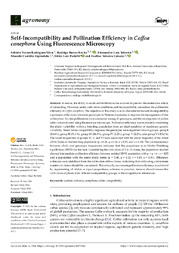Self-incompatibility and pollination efficiency in Coffea canephora using fluorescence microscopy.
Self-incompatibility and pollination efficiency in Coffea canephora using fluorescence microscopy.
Author(s): SILVA, A. N. R.; ROCHA, R. B.; TEIXEIRA, A. L.; ESPINDULA, M. C.; PARTELLI, F. L.; CAIXETA, E. T.
Summary: In nature, the ability to avoid self-fertilization has evolved to prevent the deleterious effects of inbreeding. However, under cultivation conditions, self-incompatibility can reduce the pollination efficiency of Coffea canephora. The objective of this study was to characterize the self-incompatibility expression of the most cultivated genotypes in Western Amazonia, to improve the management of this coffee plant. In vitro pollinations were conducted among 45 genotypes, and the development of pollen tubes was evaluated using fluorescence microscopy. Pollination efficiency was evaluated considering the allelic variability within a breeding population from an ideal condition of maximum genetic variability. Based on the compatibility response, the genotypes were organized into six groups: group I (24.4%), group II (31.1%), group III (24.4%), group IV (2.2%), group V (2.2%), and group VI (15.6%). The lower frequencies of groups IV, V, and VI were associated with the lower frequency of the rarest allelic forms in this breeding population (p = 0.36, q = 0.26, r = 0.29, and s = 0.10). The correspondence between allelic and genotypic frequencies indicates that this population is in Hardy–Weinberg equilibrium (HWE) for this trait. Considering the cultivation of 2 to 10 clones, the population studied showed intermediate pollination efficiency between an ideal HWE population with p = q = r = s = 0.25 and a population with the rarest allelic forms (p = 0.48, q = 0.32, r = 0.19, s = 0.01). Efficiency estimates were stabilized from the cultivation of five clones, indicating that cultivating a minimum number of clones should be considered. Theoretically, maximum pollination efficiency is achieved by representing all alleles in equal proportions, whereas in practice, farmers should ensure the cultivation of plants from different compatibility groups, without significant imbalances.
Publication year: 2024
Types of publication: Journal article
Unit: Embrapa Coffee
Keywords: Coffea Canephora, Fluorescence microscopy, Polinização, Pollination
Observation
Some of Embrapa's publications are published as ePub files. To read them, use or download one of the following free software options to your computer or mobile device. Android: Google Play Books; IOS: iBooks; Windows and Linux: Calibre.
Access other publications
Access the Agricultural Research Database (BDPA) to consult Embrapa's full library collection and records.
Visit Embrapa Bookstore to purchase books and other publications sold by Embrapa.

